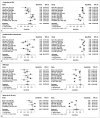Diagnostic Accuracy of Magnetic Resonance Imaging Features and Tumor-to-Nipple Distance for the Nipple-Areolar Complex Involvement of Breast Cancer: A Systematic Review and Meta-Analysis
- PMID: 37500575
- PMCID: PMC10400374
- DOI: 10.3348/kjr.2022.0846
Diagnostic Accuracy of Magnetic Resonance Imaging Features and Tumor-to-Nipple Distance for the Nipple-Areolar Complex Involvement of Breast Cancer: A Systematic Review and Meta-Analysis
Abstract
Objective: This systematic review and meta-analysis evaluated the accuracy of preoperative breast magnetic resonance imaging (MRI) features and tumor-to-nipple distance (TND) for diagnosing occult nipple-areolar complex (NAC) involvement in breast cancer.
Materials and methods: The MEDLINE, Embase, and Cochrane databases were searched for articles published until March 20, 2022, excluding studies of patients with clinically evident NAC involvement or those treated with neoadjuvant chemotherapy. Study quality was assessed using the Quality Assessment of Diagnostic Accuracy Studies 2 tool. Two reviewers independently evaluated studies that reported the diagnostic performance of MRI imaging features such as continuity to the NAC, unilateral NAC enhancement, non-mass enhancement (NME) type, mass size (> 20 mm), and TND. Summary estimates of the sensitivity and specificity curves and the summary receiver operating characteristic (SROC) curve of the MRI features for NAC involvement were calculated using random-effects models. We also calculated the TND cutoffs required to achieve predetermined specificity values.
Results: Fifteen studies (n = 4002 breast lesions) were analyzed. The pooled sensitivity and specificity (with 95% confidence intervals) for NAC involvement diagnosis were 71% (58-81) and 94% (91-96), respectively, for continuity to the NAC; 58% (45-70) and 97% (95-99), respectively, for unilateral NAC enhancement; 55% (46-64) and 83% (75-88), respectively, for NME type; and 88% (68-96) and 58% (40-75), respectively, for mass size (> 20 mm). TND had an area under the SROC curve of 0.799 for NAC involvement. A TND of 11.5 mm achieved a predetermined specificity of 85% with a sensitivity of 64%, and a TND of 12.3 mm yielded a predetermined specificity of 83% with a sensitivity of 65%.
Conclusion: Continuity to the NAC and unilateral NAC enhancement may help predict occult NAC involvement in breast cancer. To achieve the desired diagnostic performance with TND, a suitable cutoff value should be considered.
Keywords: Breast cancer; Diagnostic performance; Magnetic resonance imaging; Nipple sparing mastectomy; Nipple-areolar complex.
Copyright © 2023 The Korean Society of Radiology.
Conflict of interest statement
The authors have no potential conflicts of interest to disclose.
Figures






Similar articles
-
MIP image derived from abbreviated breast MRI: potential to reduce unnecessary sub-nipple biopsies during nipple-sparing mastectomy for breast cancer.Eur Radiol. 2021 Jun;31(6):3683-3692. doi: 10.1007/s00330-020-07550-w. Epub 2020 Nov 27. Eur Radiol. 2021. PMID: 33247343
-
A novel MRI-based predictive index can identify patients suitable for preservation of the nipple-areola complex in breast reconstructive surgery.Eur J Surg Oncol. 2021 Feb;47(2):225-231. doi: 10.1016/j.ejso.2020.08.010. Epub 2020 Aug 23. Eur J Surg Oncol. 2021. PMID: 32950315
-
Diagnostic Accuracy of Nonmass Enhancement at Breast MRI in Predicting Tumor Involvement of the Nipple: A Prospective Study in a Single Institution.Radiology. 2021 Oct;301(1):47-56. doi: 10.1148/radiol.2021204136. Epub 2021 Jul 13. Radiology. 2021. PMID: 34254854
-
Spare the Nipple: A Systematic Review of Tumor Nipple-Distance and Oncologic Outcomes in Nipple-Sparing Mastectomy.Ann Surg Oncol. 2023 Dec;30(13):8381-8388. doi: 10.1245/s10434-023-14143-6. Epub 2023 Aug 24. Ann Surg Oncol. 2023. PMID: 37620525
-
Tumor-to-nipple Distance Should Not Preclude Nipple-sparing Mastectomy in Breast Cancer Patients. Personal Experience and Literature Review.Anticancer Res. 2020 Jun;40(6):3543-3550. doi: 10.21873/anticanres.14343. Anticancer Res. 2020. PMID: 32487656 Review.
Cited by
-
Safety of Atypical Ductal Hyperplasia at the Nipple Margin in Nipple-Sparing Mastectomy.J Breast Cancer. 2024 Aug;27(4):260-269. doi: 10.4048/jbc.2024.0077. Epub 2024 Jul 16. J Breast Cancer. 2024. PMID: 39069781 Free PMC article.
-
Performance of contrast-enhanced cone-beam breast CT to predict nipple-areolar complex involvement in early-stage breast cancer.Eur Radiol. 2025 Jul 1. doi: 10.1007/s00330-025-11787-8. Online ahead of print. Eur Radiol. 2025. PMID: 40593168
References
-
- Smith BL, Tang R, Rai U, Plichta JK, Colwell AS, Gadd MA, et al. Oncologic safety of nipple-sparing mastectomy in women with breast cancer. J Am Coll Surg. 2017;225:361–365. - PubMed
-
- Petit JY, Veronesi U, Orecchia R, Curigliano G, Rey PC, Botteri E, et al. Risk factors associated with recurrence after nipple-sparing mastectomy for invasive and intraepithelial neoplasia. Ann Oncol. 2012;23:2053–2058. - PubMed
-
- Chan SE, Liao CY, Wang TY, Chen ST, Chen DR, Lin YJ, et al. The diagnostic utility of preoperative breast magnetic resonance imaging (MRI) and/or intraoperative sub-nipple biopsy in nipple-sparing mastectomy. Eur J Surg Oncol. 2017;43:76–84. - PubMed
Publication types
MeSH terms
LinkOut - more resources
Full Text Sources
Medical

